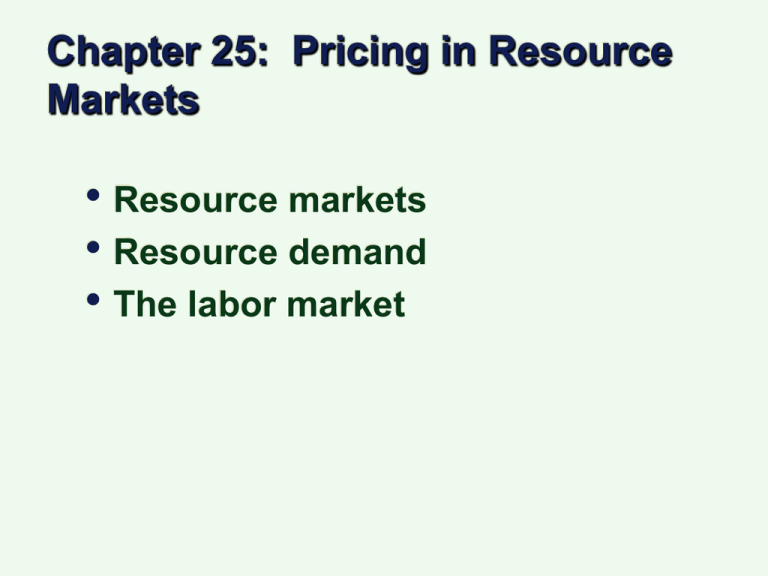chapter 11
advertisement

Chapter 25: Pricing in Resource Markets • Resource markets • Resource demand • The labor market Factor/Resource markets • Factors of production: • land labor capital entrepreneurship factor prices determined in resource markets resources markets • same concepts of demand and supply now applied to factors of production resource demand • producer will demand an additional unit of resource if MR of resource > MC of resource example: Wal Mart • labor market • 1 more clerk costs $400 per week • 1 more clerk increases revenue by • $500 week hire 1 more clerk? Yes! $500 > $400 example: lawn service • capital market • larger, faster mower costs extra • • $400/wk. but mow more lawns, extra $600/wk. in revenue buy the mower? Yes! $600 > $400 terms • marginal revenue product (MRP) • extra revenue from one more unit of resource marginal resource cost (MRC) extra cost for one more unit of resource rule for resource demand • firm hires additional resources until MRC = MRP cost of the extra resource = extra revenue from the resource resource supply • you will supply your resources to the • “best” option highest paying (if all else equal) nonmonetary factors are important firms must compensate when jobs are dirty, dangerous, illegal….. The Market for Resources • resource demand downward sloping producers less willing, able to buy resources at higher prices • resource demand is a DERIVED demand it depends on the demand for the final product examples • demand for nurses • • depends on demand for healthcare demand for steel depends on demand for cars demand for plywood depends on demand for houses Shifts in demand for a resource • demand for final product • if product demand rises, MRP rises resource demand shifts right productivity of resource better resource, higher MP & MRP resource demand shifts right examples • increase demand for healthcare • increase demand for nurses increase demand for syringes higher-skilled labor increases demand for labor • price of other resources if price of substitute resource falls -- substitute cheaper resource -- demand for original resource shifts left example • bank ATMs vs bank tellers ATM costs falls -- demand for bank tellers falls example • office buildings • skyscrapers in Manhattan 3 stories in Oswego why? cost of land vs. cost of construction if price of complement resource falls -- use more of both resources -- demand for original resource shifts right example • price of trucks (18-wheeler) fall increase demand for truck drivers note • sometimes resources are BOTH substitutes and complements: computers do some clerical functions AND need clerical workers to operate them • technology decrease demand for some types of labor increase demand for other types of labor example • better/cheaper computer technology increases demand for programmers decrease demand for architects • resource supply upward sloping suppliers more willing, able to provide resources at higher prices P res. S P* D Q* Q res. resource prices • • tend to equalize across alternative uses carpenters for houses carpenters for furniture UNLESS other nonmonetary differences economics professors vs. business economists land in Manhattan vs. land in Oswego The Labor Market • Labor supply • Labor demand • Earnings differences Labor Supply • time is a scarce resource market work (for pay) nonmarket work (not for pay) (cleaning, studying) leisure (for fun) work and utility • work is a disutility but allows you to buy stuff or to enjoy stuff (clean house, dinner, good grades) • tradeoff between consumption & leisure work to buy stuff or to make stuff but working leaves less time for leisure implications • higher wages = higher opp. cost of leisure, nonmarket work most surgeons don’t mow their lawn many college sports stars head to the draft early Effect of a wage increase • two effects: substitution effect income effect substitution effect • as wage rises • opp. cost of other time uses rises spend more time on market work Qs of labor rises as wages rise income effect • as wages rise • income rises consumer more of what you like: -- stuff, leisure Qs of labor falls as wages rise • if substitution effect > income effect • • labor supply is upward sloping if substitution effect < income effect labor supply is downward sloping which is it? labor supply • economists observe • upward sloping for most wages downward sloping at very high wages backward-bending supply curve S wage subst. < inc. effect subst. > inc. effect Q labor Changes in market labor supply • adult population births rates, immigration increase will shift labor supply right • preferences willingness of groups to work women have increasingly entered labor force -- shift labor supply right • skills, education, training education increases opp. cost of not working for pay -- labor supply increases with education increase HS, college graduation -- increase supply high-skill labor -- decrease supply low-skill labor • other sources of income nonwage income lowers labor supply less labor supply among those over 50 with the growth of pensions, disability less labor supply among women with high-earning husbands Labor demand • firm’s demand for labor • car wash • perfectly competitive marginal revenue product (MRP) change in total revenue when one more unit of labor is hired example: car wash • • price of car wash = $3 car washes per hour Q labor TP 0 1 0 5 2 3 4 5 9 12 14 15 MP MRP 5 4 3 2 1 15 12 9 6 3 how much labor to hire • MC of one more unit of labor • • marginal resource cost (MRC) wage MR of one more unit of labor MRP hire until MRP = wage • if MRP > wage • hire more labor and still add to profit if MRP < wage last units labor taking away from profit, hire less labor wage 15 if wage = $9 hire 3 units labor 12 9 6 3 LD 1 2 3 4 5 Q labor wage 15 wage = $12, hire 2 12 9 wage = $6, hire 4 6 3 LD 1 2 3 4 5 Q labor Earnings differences • based on both demand-side and supply side factors Human Capital • • • • Skill set Education, training, experience increases MP of labor & labor demand cost of education means supply of skilled labor lower relative to unskilled labor result is a higher market wage ability/talent • Human capital, but hard to measure • the best athletes, most popular movies stars, CEOs command HUGE salary premium over others Efficiency wage theory • Higher pay leads to better • productivity Why? Better morale, lower turnover “Cherry pick” the best workers Workers do not want to risk losing job Non-wage job characteristics • Risk/danger • Working conditions • Work is meaningful or glamorous Holding all else constant, • dangerous jobs pay more • jobs with higher layoff probability pay more geography • wages higher in U.S. • • encourages immigration teacher’s salaries vary significantly by state wages lower in South than Northeast discrimination • age, race, gender • wage differentials remain EVEN after controlling for other factors occupation education/experience risk unionization • union workers earn more than nonunion workers doing the same jobs janitors auto workers teachers 26. Markets for Capital and Natural Resources • Financial markets • Natural Resource markets Financial Markets • Demand for financial capital • Supply of financial capital • interest rate • financial capital = loanable funds Demand for Financial capital • firms demand funds to finance • capital purchases higher interest rate, more expensive to borrow lower Q demanded of funds interest rate D Q funds Shifts in demand for funds • population growth increase demand for goods, increase demand for capital, increase demand for funds • technology increase demand for new capital, increase demand for funds to finance it • Government borrowing Federal gov’t deficits shift demand to the right Supply of Financial capital • • people’s savings decisions tradeoff between consuming today & consuming tomorrow • Time preference higher interest rates encourage saving higher opportunity cost of current consumption higher Q supplied of funds Shifts in supply of funds • population • higher population, more saving supply shifts right income higher income, more savings supply shifts right • expected future income save today based on future needs -- retirement, college save to smooth consumption over time expect income to rise -- save less today, supply falls expect income to fall -- save more today, supply rises Financial market equilbrium interest rate S i* D Q* Q funds Natural Resource markets • renewable resources • land, forests, livestock nonrenewable resources fossil fuels, metals Market for land • supply is fixed for type or location perfectly inelastic rent S r* D Q* Q land economic rent • rent for land is special • land is available even if rent=0 demand affects P, not Q economic rent rent above what is required to induce Q supplied of factor rent S economic rent r* D Q* Q land • Pure economic rent Income earned by resource with a perfectly inelastic supply Economic Rent • amount of resource earnings ABOVE opportunity cost • or resource earnings – minimum required earnings • “gravy”! “bonus”! example: Shaquille O/Neal • 2000: $35 million • what is minimum for which he would • play basketball and endorse stuff? suppose $1 million economic rent: $34 million when do resources earn rent? • less elastic (more inelastic) the supply, more rent as a % of total earnings Differential rent • Rents earned to superior units of a • resource Where quality of resource affects productivity Examples Highly fertile farmland Highly skilled trial lawyer Inframarginal rent • Total rent when units of resource • differ in their opportunity costs What causes differences? Differences in objectives Differences in constraints examples • Nursing • Find the work rewarding Other constraints in the job market Teaching summer school Presence of small children Children in college upward-sloping supply earnings split P res. S P* rent opp. cost D Q* Q res. Supply of nonrenewable resource • at point in time Q is fixed • but over time use -- decrease supply new discoveries -- increase supply technology for better use -- decrease demand example: metals • nonrenewable resource • discover new sources • use substitutes (plastic) • Recycling technology Market-guided conservation • Markets have built-in incentives for • efficient resource use If a resource becomes scarce Prices rise • Copper is up 50% in 2006 • If prices rise People use less (conserve) People substitute Firms look for new sources Firms look for alternatives Problems with markets & nonrenewable resources • • • Externalities Extraction of oil, metals, natural gas have huge negative externalities Market results in too much extraction Government policies Major tax breaks to domestic energy producers Prices may not be sending the right signals Doomsday scenarios • Aka • “We are running out of everything and we are all going to die” Paul Ehrlich The Population Bomb, 1968 • • "a major food shortage in the United States in the 1970s. . .hundreds of millions of people are going to starve to death." By 1999 U.S. population would be only 23 million (actual 1999 U.S. population = 288 million) Limits to Growth 1974 World will run out of • gold by 1981 • mercury by 1985 • tin by 1987 • zinc by 1990 • petroleum by 1992, and • copper, lead, and natural gas by 1993 An economist’s refutation: • Julian Simon • The Ultimate Resource (1983) • Hoodwinking the Nation (1999) • Doomsayers underestimate human ingenuity Simon vs. Ehrlich • Made a bet in 1980 for $1000 • Simon bet price of 5 key metals • would be LOWER in 1990 Signaling less scarcity Simon won. Ehrlich paid Simon offered to renew the bet, Ehrlich refused Real concerns about resources today: • Has natural gas production peaked • Will oil production soon peak? Hubbert’s curve • • Are we running out of copper? Are we past the tipping point on global warming? BUT…. • Doomsayers need to take some responsibility for lack of world action








